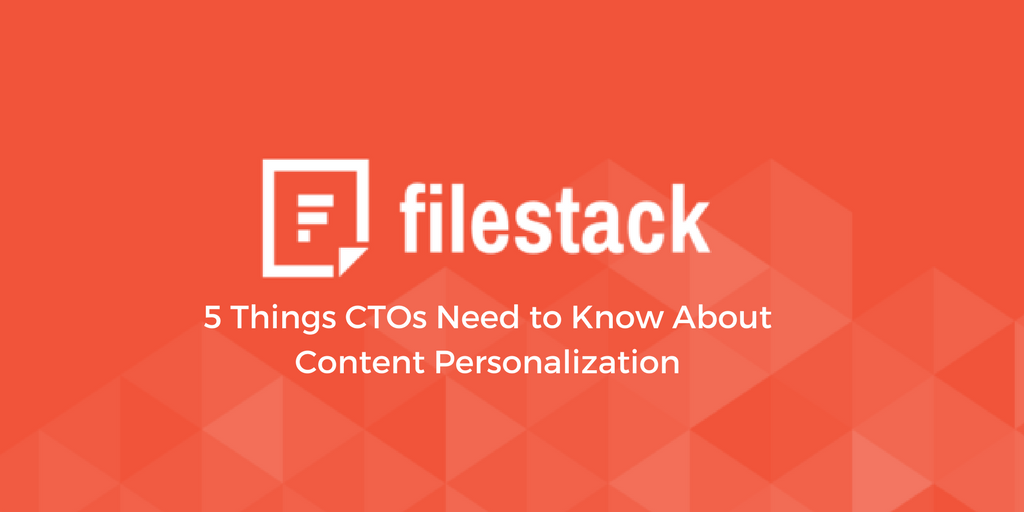Content personalization relies on both a “push model,” where users submit their own content for consumption, and a “pull model,” where content is served to the user based on their preferences. But personalization doesn’t exist in a technological vacuum.
Content must be reviewed for appropriateness, categorized, verified and distributed. That’s why CTOs should be prepared to address this top 5 list of concerns as they look to adapt to a world where user-generated content is growing more prevalent. These concerns include:
- Content Moderation
- Curation
- Security
- Cognition
- Delivery
Let’s get started.
Content Moderation and Brand Influence
User-generated content (UGC) is quickly becoming an important tool for building brand recognition and trust. Millennials surveyed found UGC to be 50% more trustworthy and 35% more memorable than any other form of media. An increasing number of businesses are clamoring to monetize UGC, because 53% of millennials surveyed said UGC helped influence a purchase decision. Adding to that, statistics show 25% of search results for the world’s 20 largest brands are linked to UGC. It’s no wonder this type of personalization is welcomed by more and more businesses.
But there is inherent risk in leveraging UGC. You want users to portray your brand in a positive light while protecting visitors from the presence of offensive or even harmful content such as nudity, violence and malware. Content moderation is the answer to this dilemma, but the real challenge is scaling a moderation solution to accommodate high volumes of UGC while protecting your customers, your reputation and your revenue stream. Scalability is the operative word here.
There are other advantages to content moderation that go beyond protecting visitors from offensive content. Content moderation can aid in identifying patterns by tagging content with key properties. This allows data analysts to gain actionable insights from UGC regarding user and customer behavior. A scalable content moderation strategy can also improve user engagement and boost traffic to your online properties. Finally, scalable content moderation can help your organization improve its bottom line by boosting awareness and the propensity to purchase.
Filestack enables developers to tap into a comprehensive and scalable platform to perform complex content workflow operations with a very simple API. Filestack provides the platform to access end user content wherever it exists and then personalizes the experience of that user by curating every piece of content through comprehensive content workflows. The personalized experience is delivered to the user across every device on any network.
The Challenge of Content Curation and UX
In recent years, the trend toward visual search has boomed for e-commerce. Visual search tools allow consumers to upload “inspirational images” to an application and shop for products in the image. It’s no surprise consumers want to speed up purchase transactions, and that’s a good thing for both the consumer and the retailer.
Image tagging, attribute tagging, or computer vision is one way to speed up backend processes by automatically tagging images with attribute labels for both physical and aesthetic qualities. This capability offers consumers a highly personalized experience since the retailer has information on the consumer’s style preferences. What’s more, image tagging helps curation teams build shopable content or distribute UGC for publishers, brands and retailers.
Image tagging leverages a collection of algorithms designed to recognize various kinds of objects in images. This allows for automated content curation and inference, a powerful tool for making decisions about image data without the need for manual analysis. Filestack’s Image Tagging API, for example, provides state-of-the-art computer vision with a single HTTP call.
A problem facing many e-commerce retailers is building classifiers for product data tagging, which is a faster and more scalable approach. A key challenge is the proliferation of taxonomies used to describe merchandise. One brand may call something a “shirt,” another “blouse,” and yet another “polo.”
One way to go around this is by populating the field with a list of suggested tags. This can be accomplished using Filestack’s Picker, our image tagging micro-service, and any general HTML form. By presenting a list of tags to the user and allowing them to click on each to populate an input field, we have taken a task and turned it into a few clicks.
Want to talk?
Get in contact now
Content Security Dangers
There are essentially two ways file uploads can pose a security risk. In the first case, a file can overwrite another file with the identical name. If it is a critical file, it could affect how a website functions or shut it down completely. It may also be used to replace an existing page or edit the list of allowed file types to simplify future attacks.
A second attack approach uses malicious file uploads to introduce malicious code in the form of an exploit, virus or other malware with the aim of gaining control of the web server. It’s widely known that malicious code can be hidden in an image, even though the image appears fine. Once opened, the image can execute hidden code and cause a really bad day for system administrators.
Filestack’s approach involves proactive security verification that detects viruses, malicious code and other malware and quarantines uploads before they can inflict damage. Although there are countless possible workflow combinations, Filestack can help organizations construct a security workflow which allows developers to chain together tasks using an intuitive graphical interface and execute them with a single API call.
Content Cognition and Its Applications
Object detection deals with detecting instances of semantic objects in digital images and videos. The problem arises in the variability of objects within the image, since the number of objects detected in an image may change based on the image. Another issue is the ability of the API to discern between objects that closely resemble each other. Take for example the Chihuahua vs. Muffin test.

Here we must have confidence that the object recognition is trained to differentiate between similar images and objects.
Application of this technology in e-commerce is largely in image classification, augmented reality and content filtering. Today we will focus on image classification and content filtering.
Instagram beautifully illustrates the use case for e-commerce. An Instagram follower likes a post of a celebrity in a blue skirt and wants to purchase one. She uploads the image to her favorite retailer’s webpage and an object recognition API will return a set of keywords from the image. These could include blue skirt, brown handbag, gold bracelets. She can then narrow her search to the blue skirts and consider the options recommended by the website. Technology has streamlined this process removing the need for human intervention.
This same image recognition API can also filter inappropriate content, adding a layer of protection. The retailer can confidently encourage shoppers to upload images without the possibility of inappropriate content on their site.
There are countless insights in your images. Tagging and filtering help you turn your images into data to drive your business. Filestack has partnered with the best machine learning technology to deliver quick analysis of your images and drive actionable insights.
Content Delivery That Delivers a Consistent Experience
The benefits of a CDN are numerous. They can improve website load times, reduce bandwidth costs, increase content availability and redundancy, and improve security. E-commerce retailers rely on CDNs to rapidly load pages and process transactions. Slow load speeds can increase shopping cart abandonment or negatively impact brand affinity.
To deliver lightning fast speed, anywhere in the world, Filestack partners with Fastly CDN. Filestack’s integration ensures fast page load times by optimizing assets for speed.
Conclusion
CTOs must be keenly aware of the pitfalls of not properly managing a personalized content experience. Consideration must be given to the appropriateness of the content, how it is tagged and categorized, any threats it may pose, its composition and how it is delivered and consumed by users. CTOs with a focus on personalized content will drive increasing revenue, customer satisfaction, customer loyalty, and brand identity and affinity.
Filestack is a dynamic team dedicated to revolutionizing file uploads and management for web and mobile applications. Our user-friendly API seamlessly integrates with major cloud services, offering developers a reliable and efficient file handling experience.
Read More →
